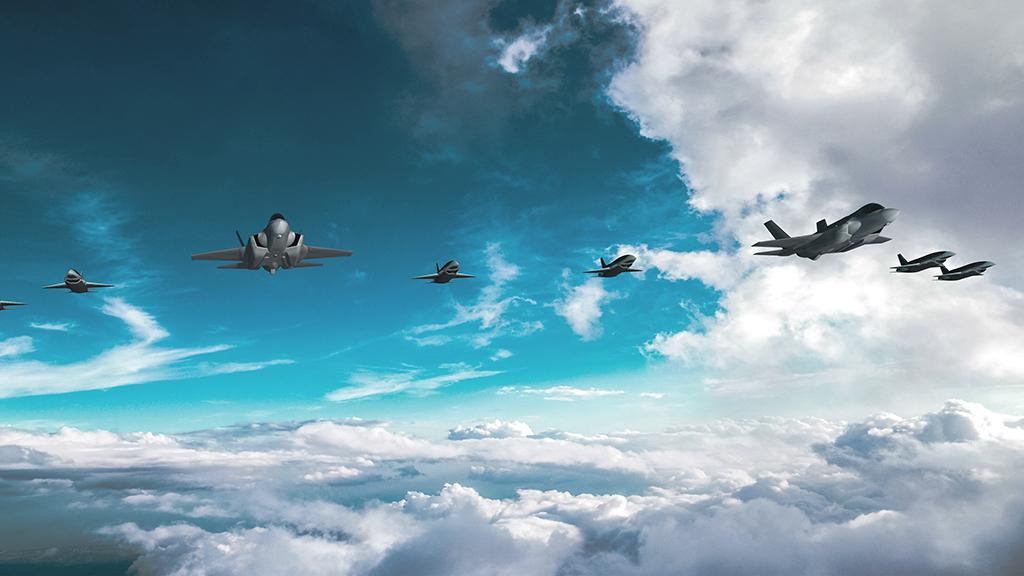
When Will Roper, the former U.S. Air Force acquisition chief, called for applying unmanned aircraft systems (UAS) to the adversary air mission in an interview in January with Aviation Week (AW&ST Feb. 8-21, p. 46), the founder of an experimental aircraft prototype manufacturing company in North Carolina noticed.
For two years, Blue Force Technologies has been developing a UAS called REDMedium to perform as much as 60% of the adversary air training mission for the Air Force.
- REDMedium Iron Bird set for July test
- First flight could follow 22 months after contract signing
“Obviously, [Roper’s comments] got our attention because that’s been our swim lane for a couple of years, and we’ve got a good head start,” says Scott Bledsoe, the founder and president of Blue Force Technologies.
Roper, who stepped down as assistant secretary of the Air Force for acquisition, technology and logistics on Jan. 20, raised the possibility of using low-cost, or attritable, UAS for the adversary air mission in an interview.
“I think, at a minimum, attritables ought to take on the adversary air mission as the first objective,” Roper told Aviation Week.
Roper’s comment echoes Blue Force Technologies’ business plan for REDMedium. A Phase II Small-Business Innovation Research (SBIR) contract awarded by Air Combat Command (ACC) calls for the company to build an iron bird systems simulator of the jet-powered UAS by July.
The company also is waiting for a follow-on award that could fund development and flight trials of a full-scale test aircraft, with a first flight possible within 22 months of award.
Blue Force Technologies is one of 13 companies qualified to compete for task orders under the Air Force Research Laboratory’s Skyborg program, which seeks to develop a family of UAS that would be piloted by an artificial intelligence core integrated by Leidos.The funding of the RED-Medium UAS could come as a follow-on to the SBIR award, a new task order under the Skyborg program or other acquisition channels, Bledsoe says.
The role is a major step forward for Blue Force Technologies, which was launched 10 years ago to manufacture experimental aircraft prototypes. Recent examples of the company’s work include the prototype airframe for Beta Technologies’ Alia electric vertical-takeoff-and-landing) air taxi.
In early 2018, Blue Force Technologies decided to investigate options to build its own aircraft designs and identified a high-performance, jet-powered UAS for the military as an accessible niche. The company’s first idea was an aircraft designed for penetrating intelligence, surveillance and reconnaissance, but an early meeting with ACC officials reoriented them to a UAS dedicated to the adversary air mission.
The Air Force has budgeted an average of $620 million annually to pay a group of contractors to provide decommissioned military fighters to serve as adversary, or “red air,” forces in training. Bledsoe estimates up to 60% of missions flown by such contractors could be replaced at significantly lower cost by a UAS, such as RED-Medium.
Brett Abbamonte, military advisor to Blue Force Technologies, previously flew Lockheed Martin F-35Bs for the U.S. Marine Corps. The majority of his F-35B training did not involve dogfighting, but he did practice beyond-visual-range (BVR) engagements with adversary aircraft carrying pods that emulate the signatures of Chinese or Russian electronic systems such as radars, electronic warfare and infrared search-and-track sensors.
“There would be weeks on end where I would fly multiple sorties and never visually see a Red aircraft because, if we’re doing our jobs correctly, we’re killing them all BVR,” Abbamonte says.
Blue Force Technologies has partnered with the makers of electronic warfare emulator pods, including the Georgia Tech Research Institute, to integrate such systems on the RED-Medium. Moreover, the company has partnered with Autonodyne, which develops autonomous flight control systems.
The combination of the emulator pods, autonomous controls and a high-performance airframe should allow the REDMedium to replicate BVR signatures of the most sophisticated Chinese and Russian fighters and cruise missiles, says Andrew Van Timmeren, a former Air Force F-22 pilot advising Blue Force Technologies. The goal is to allow the Air Force operator to reconfigure the RED-Medium in flight to emulate a different aircraft by selecting an option on a pull-down menu.
“We’ve decided on the term ‘software-defined aircraft,’” Van Timmeren says. “You can select what the aircraft will replicate based on a simple couple of clicks on the ground decontrol station.”
The Air Force will still need manned fighters to practice basic fighter maneuvers, but a purpose-built UAS designed to emulate adversaries could offer a low-cost alternative to contracted air services. In the process, Air Force fighter pilots would gain new exposure to flying in the same airspace with UAS partners to complete a mission.





